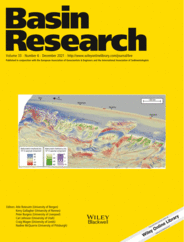
Full text loading...
 , N. W. Hayman1,3, S. P. S. Gulick1,2, K. L. Milliken4, D. F. Stockli2, H. Masago5
, N. W. Hayman1,3, S. P. S. Gulick1,2, K. L. Milliken4, D. F. Stockli2, H. Masago5
Understanding sedimentary routing systems at continental margins can be challenging in tectonically active regions such as forearc basins. Here, we combine sand modal composition and detrital zircon U‐Pb data from the Kumano Basin and surrounding Nankai Trough region of Japan to explore sedimentation in an active forearc and its linkages to the regional tectonic history. Our analyses are on Miocene‐to‐Pleistocene samples collected by the Integrated Ocean Drilling Program (IODP) at inner and outer forearc basin sites C0009 and C0002, river samples from onshore Honshu, and published results from other Nankai IODP sites. Results show the sediments of many IODP samples are similar to that of the modern rivers. Data from C0009 demonstrate that the early accretionary prism already contained slope basins fed by sediments similar to those in the modern Kumano River by 7.1 Ma. The more distal C0002 section was predominantly fed by a system similar to the modern Yodo River, located to the west‐southwest. We conclude that the section was therefore tectonically transported, in agreement with the ‘mobile model’ of oblique tectonic convergence across SW Japan during late Miocene time. Deposition resumed after a ca. 5.6–3.8 Ma hiatus, with sediments primarily fed from the paleo‐Kumano River, with some input from the paleo‐Tenryu and Kiso/Nagara rivers located to the northeast. Input from the paleo‐Tenryu and Kiso/Nagara rivers was likely re‐routed towards the trench by ca. 1.3 Ma. Sediments similar to those of the distal Yodo River also make up part of the Kumano basin fill and are best explained by erosion of uplifted older accretionary prism sediments along the Megasplay Fault that bounds the forearc basin. Despite the temporal variability in sedimentation routed to the basin, basin‐fill dynamics appear to have been governed primarily by the critical‐wedge style dynamics driven by variations in frontal accretion and in‐ or out‐of‐sequence thrusting response.

Article metrics loading...

Full text loading...
References


Data & Media loading...

